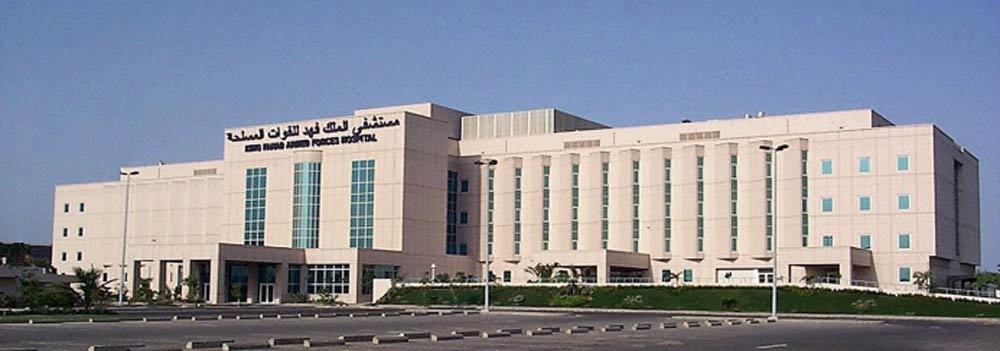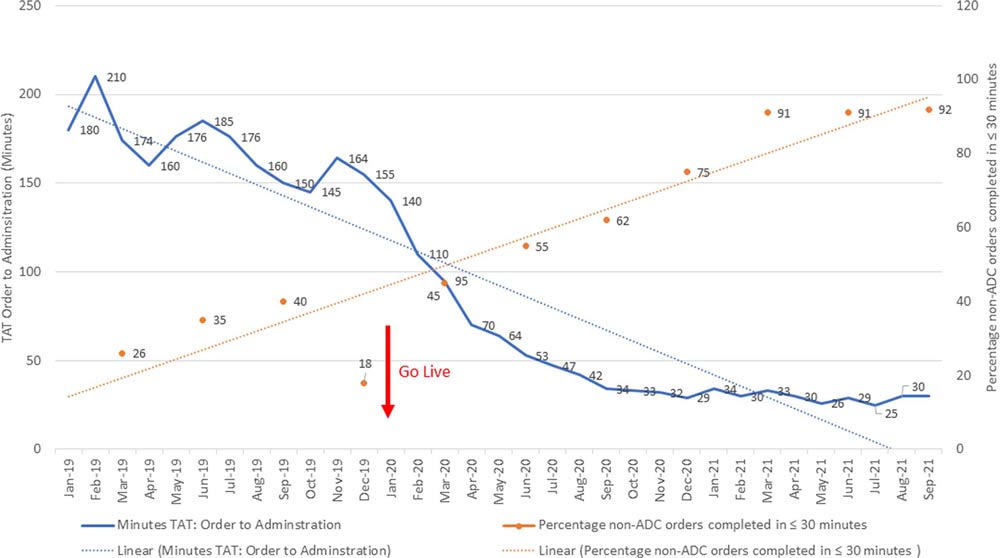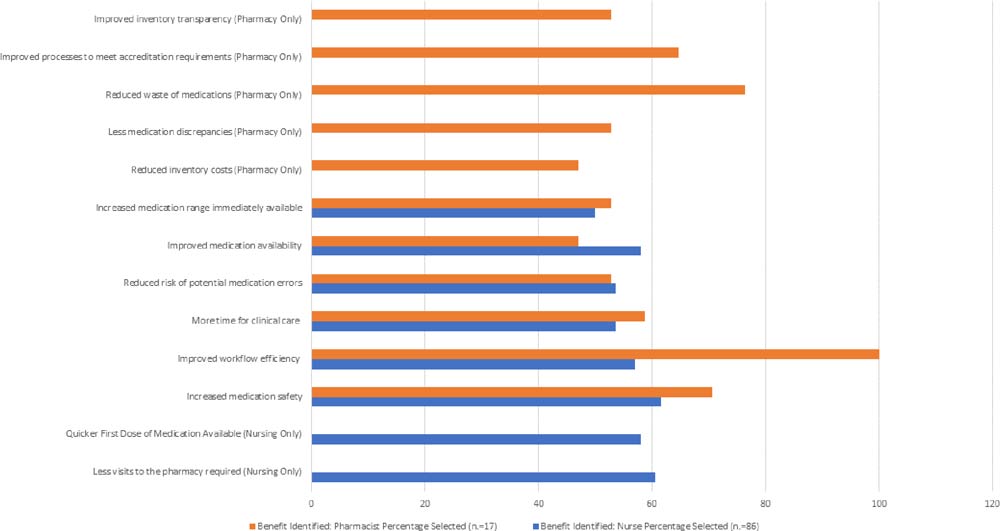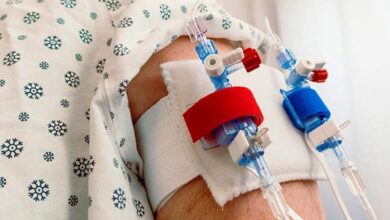Transparency and Automation: Drivers of Safer, Simpler, and More Efficient Inpatient Medication Management
Amr Ashmawy. B.Pharm. Clinical Solution Specialist, Dispensing, Medication Management Solutions. Becton Dickinson Middle East and Africa.
Maged Farrag. BSc, ACIM. Business Development Manager – Medication Management Solutions. Becton Dickinson. Kingdom of Saudi Arabia..
James Waterson. M.Med.Ed, M.HEc, RN. Medical Affairs Manager. Medication Management Solutions. Becton Dickinson, Middle East & Africa.
A recent systematic review of the literature describes how facilities that have embraced automated drug dispensing technologies can streamline processes, minimize medication errors, and boost safety for patients and clinicians. The study was positive on the effect of automation on safety and efficiency but found some issues with the literature reviewed as much of the work undertaken was observational, and difficult to generalize upon as the studies assessed either the ward environment or the central pharmacy, without tracing the medication handling relationship between the two areas.1
The authors recognized the limitations of the review they undertook against the backdrop of a multifaceted landscape of activities that includes prescription, preparation, dispensing, and administration of medications to patients, as well as the requirement for observation of effectiveness and for adverse events or side effects.1 The review also recognized that manual dispensing often involves ward nurses and pharmacists in tasks that can be automated, and which may take them away from value-added clinical activities.
In terms of the efficiencies and improved transparency of medication management that may be obtained through automation and by the implementation of integrated and connected medication management, the review’s authors suggest that the case for automation during dispensing from central pharmacy has been largely proven by the literature to date but that what is missing from the evidence base is a comprehensive analysis of the supplementary benefits and advantages resulting from implementing integrated solutions both in the centralized pharmacy and the ward.

A recently published paper from our region2 has done a lot to fill in the gaps that have been previously missed in the scientific literature. The study, which was undertaken at the King Fahad Armed Forces Hospital (KFAFH) in Jeddah, in the Kingdom of Saudia Arabia, over a period of 21 months sought to identify the possible benefits of automation in nursing units through the deployment of BD Pyxis™ Automated Dispensing Cabinets (ADCs), with integration of these units into the central pharmacy via BD Medication Knowledge Portal software.

BD Medication Knowledge Portal provides analytical tools that specifically target health system analytics, inventory and cost reduction, safety and compliance. It provides a single access point to analyze data from BD Pyxis™ ADCs, and can also access BD Pyxis™ Anesthesia stations, and BD Pyxis™ CII Safe units. We specifically discussed the value of all these units for controlled substance management in our article in November 2023 for “Hospitals” Magazine.3
BD Medication Knowledge Portal provides an analytical view of aggregated data and retrospective reporting for up to ten years. It has Key Performance Indicator (KPI) reports related to inventory management, safety and compliance, and system maintenance. These can be powerful tools for assessing the benefits of change and the maintenance of gains made following the introduction of automation into a facility’s pharmacy system.
The KFAFH pharmacy team set out to tackle a number of incredibly important issues for medication management in their 600-bed military hospital. A Six-Sigma approach was applied with the following goals to be achieved: The overall objective was to instigate automation and deploy staff reorientation, workflow change, and integration, and to measure any improvements in inpatient medication management service in terms of safety, efficiency, and costs.
Specific goals were:
- Change in the management of expensive and frequently misused medications.
- Implementation of a secondary approval process for restricted medications.
The primary outcome aims were:
- To decrease turnaround time from ordering to administration of regular and stat medications by more than 70% by the end of 2021.
- To decrease inpatient monthly consumptions by more than 20% by the end of 2021.
- To decrease the number of ward stock items by more than 70% by the end of 2021.
- To decrease the number of returned items by more than 70% by the end of 2021.
- To decrease loss due to expired medications in both the central pharmacy and the warehouse by more than 70% by the end of 2021.
- To decrease the number of delayed stat and regular prescription medication incidents to zero by the end of 2021.
The secondary aims were:
- To improve the percentage of effectively answered medication related calls handled by the pharmacy from nursing units by more than 70% by the end of 2021.
- To monitor nursing and pharmacy staff satisfaction with the new medication management processes, and to support acceptance and assurance with the solution through training and acting promptly on feedback.
Failure Mode Effect Analysis (FMEA) Risk Priority Numbers (RPNs), incident reporting, staff surveys, appraisal of the number of calls effectively managed by the pharmacy department related to medication management, and the metrics available from BD Pyxis™ and BD Knowledge Portal, as well as manual inventory counts during the switch to the new technology were used to triangulate the impact of the introduction of BD Pyxis™ ADCs.
Of particular interest in the KFAFH study were the reengineered workflows for expensive, misused, and restricted medications, number of telephone calls to the pharmacy from nursing units, overall, and increasing the number of successfully managed medication-related calls is very much in line with the zeitgeist of attempting to reduce immediate or stat need for medication calls to the pharmacy, and the difficulties this causes in traditional non-connected medication management systems for managing urgent orders alongside the routine work of restocking nursing units.
In terms of results, the KFAFH study was hugely impressive. Following the implementation of BD Pyxis™ ADCs and Medication Knowledge Portal, and despite the enforced changes required by the 2019 coronavirus disease (COVID-19) pandemic the below positive changes were achieved:
- Medication turnaround time: order administration decreased by 83%.
- Non-ADC Medications distributed < 30 minutes increased by 39%.
- Delay incidents reported via quality system showed zero incident.
- All FMEA RPNs with pre-change scores of >100 addressed. and RPN scores reduced by 83.3% (Mean Average: Range 54.3-98%)

The results also indicated a substantial change in the total medication stock held by the facility and at risk of expiry, or loss and unavailability for immediate use within the organization:
- Loss due to expired medications was reduced by 740,000 USD.
- Monthly medication consumption was decreased by 24%.
- Annual consumption was reduced by 4,100,000 USD.
- Stock item count: Ward stock in bound stock was decreased by 81%.
- The number of returned items per month from nursing units to the pharmacy decreased by 72%.
This indicates how ADCs, when integrated and networked with a pharmacy information system can improve efficiency across a facility, when deployed via a cogent integration plan such a Six-Sigma project as was applied by the KFAFH pharmacy team. The lack of transparency, and waste inherent in traditional inventory processes is well illustrated in the KFAFH study as the project moved across the facility unit by unit, installing ADCs and removing old inventory systems of cupboards and drawers and found multiple incidences of expired medications and multiple replications of the same medication. The move to automation showed how transparency and dynamic inventory are intrinsic to the change process, and allow for calculation of return on investment to be made, once the move away from traditional systems is made.
The KFAFH team also surveyed responses from nursing and pharmacy staff. This was positive data as it indicated 64% of nurses and 67% of pharmacists stated that ADC introduction increased their productivity by more than 40%.

The number of positively answered calls by pharmacy increased by 160%. This was largely due to the number of redundant calls for missing medications overall being reduced, as nursing units had their needs met by the stock in their unit’s ADC, which had an appropriately reduced total volume of medications but an increased, and appropriate, number of medication lines suitable for their patient census available.
In summary, there is a growing global body of evidence that automation, as delivered by a disseminated pharmacy to nursing unit-based inpatient system, linked to the hospital’s central pharmacy by a connected medication management system via a system such as BD Pyxis™ and BD Medication Knowledge Portal can improve safety and efficiency across a facility. The KFAFH study indicates that regional facilities can also obtain these benefits through the application of well-planned and executed change strategies. We offer our huge congratulations and respect for the achievement of Dr Hala al-Buti’s KFAFH pharmacy team.

References:
1. Garagiola E, Foglia E, Asperti F, Antonacci G, Jani Y, Bellavia D, Schettini F. Automated Drugs Dispensing Systems in Hospital Pharmacies and Wards: A Systematic Literature Review. Biomed J Sci & Tech Res 53(5)-2023. BJSTR. MS.ID.008454.
2. Almalki A, Jambi A, Elbehiry B, Albuti H. Improving Inpatient Medication Dispensing with an Automated System. Global Journal on Quality and Safety in Healthcare 1 November 2023; 6 (4): 117–125. doi: https://doi.org/10.36401/JQSH-23-15
3. https://issuu.com/thearabhospitalmagazine/docs/hospitals_73/70
















